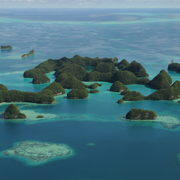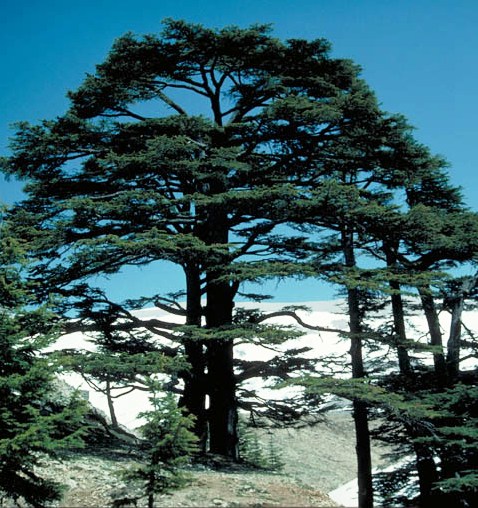Cultural landscapes and protected areas: Unfolding the linkages and synergies
World Heritage cultural landscapes embrace diverse tangible and intangible expressions of human interaction with the natural environment. Their connections with protected areas encourage holistic approaches to the conservation of the world’s intertwined cultural and natural heritage, writes Gunnar Finke.
Cultural landscapes are seen as ‘cultural heritage’ in the framework of the World Heritage Convention, yet they have considerable overlap with one of the heartland issues of nature conservation, the global coverage of protected areas. Recent research reveals the overlaps and synergies between World Heritage cultural landscapes and IUCN’s global category system for recognizing protected areas, and some of the possible implications.
Cultural landscapes are at the intersection of culture and nature. They embrace diverse tangible and intangible expressions of human interaction with the natural environment. It was in 1992 that the World Heritage Committee became the first international legal instrument to protect outstanding examples of the ‘combined works of nature and of man’. Cultural landscapes may be nominated by States Parties for inclusion in the World Heritage List under the following three categories, of which category (ii) is split into two:
(i) designed and intentionally created landscape
(ii) organically evolved landscape
– relict (or fossil) landscape
– continuing landscape
(iii) associative cultural landscape.
While they are inscribed as cultural World Heritage sites, cultural landscapes may possess significant natural values and may furthermore reflect the cultural and spiritual relationships of people with nature and the intangible, socio-cultural dimension inherent to the conservation and sustainable use of biodiversity. Such culture-nature interfaces are also encapsulated in the Operational Guidelines for the Implementation of the World Heritage Convention, which recognize that cultural landscapes ‘often reflect specific techniques of sustainable land-use, considering the characteristics and limits of the natural environment they are established in, and a specific spiritual relationship to nature. Protection of cultural landscapes can contribute to modern techniques of sustainable land-use and can maintain or enhance natural values in the landscape. The continued existence of traditional forms of land-use supports biological diversity in many regions of the world. The protection of traditional cultural landscapes is therefore helpful in maintaining biological diversity’.
It is on this basis that IUCN takes a direct interest in World Heritage cultural landscapes, working with ICOMOS which takes the lead in evaluating cultural heritage nominations for the World Heritage List. IUCN has also identified a number of natural heritage qualities that cultural landscapes may possess in its Guidelines for Reviewers of Cultural Landscapes – The Assessment of Natural Values in Cultural Landscapes (2006), including:
(i) conservation of biodiversity in wild nature (in particular natural and semi-natural systems, wild species of fauna and flora);
(ii) conservation of biodiversity within farming systems;
(iii) sustainable land-use;
(iv) enhancement of scenic beauty;
(v) ex situ collections;
(vi) outstanding examples of humanity’s
interrelationship with nature;
(vii) historically significant discoveries.
Advising on World Heritage is an important part of IUCN’s activities, but IUCN is also involved in many other areas of work, within its overall programme on nature conservation. Within the larger programme, IUCN has a global standardsetting role for protected areas, centred on the IUCN protected area management categories framework (see Guidelines forApplying Protected Area Management Categories, edited by N. Dudley, IUCN, 2008). This system outlines the concept of a ‘protected area’ and provides the definition of such areas as:
‘a clearly defined geographical space, recognised, dedicated and managed, through legal or other effective means, to achieve the long-term conservation of nature with associated ecosystem services and cultural values.’
The IUCN protected area management categories system is an international standard framework for national or subnational application. The values that IUCN-categorized protected areas protect may be of local, regional, national or international significance. As can be seen from the above definition, the IUCN protected area categories are centrally concerned with cultural values, as well as nature conservation, and the services that ecosystems provide to people. The IUCN framework organizes protected areas into the following six categories (of which category I is divided into two parts), with each category defined according to its management objectives:
- Ia strict nature reserve;
- Ib wilderness area;
- II national park;
- III natural monument or feature;
- IV habitat/species management area;
- V protected landscape/seascape;
- VI protected area with sustainable use of natural resources.
IUCN further recognizes that protected areas can be classified according to one of four governance types: governance by government; shared governance; private governance; and governance by indigenous peoples and local communities. Accordingly, any management category can exist under any of the four governance types, or vice versa.
Conceptual meeting ground
Among the protected area categories are some that specifically aim at protecting human-influenced landscapes. This is particularly the case with category V protected landscapes/seascapes, which are places where the interaction of people and nature has produced characteristic ecologically, biologically, culturally and scenically important natural values. In addition to this evident connection between World Heritage cultural landscapes and category V protected areas, it is clear however that all the cultural landscape types depict varying but substantial conceptual linkages with all the IUCN protected area categories. The strengths of these conceptual similarities however depend on the natural heritage qualities and the degree of naturalness (that is the extent to which the natural environment has been altered through human impact) present in either of the two. It is on this basis thatthe following conceptual linkages between World Heritage cultural landscapes and the IUCN protected area management categories can be identified:
- Designed and intentionally created landscapes show very little conceptual overlap with any protected area categories, although some very limited theoretical relations with certain category IV or V protected areas may occur. Designed and intentionally created landscapes may solely occur as spatially demarcated features within larger protected areas (notably category V). Yet, in some specific circumstances, the once natural environmental setting that now has been altered into a designed landscape may have contained areas with high nature conservation value. During the subsequent environmental modification of such places into the designed landscape, these areas may have been integrated as more natural constituents in garden, parkland or other designed landscape complexes.
- Relict (or fossil) organically evolved landscapes show a degree of conceptual similarity with categories II to VI protected areas. Relict (or fossil) organically evolved landscapes are a product of the past. As such, they may form part or the basis of the layered and tightly woven grid of human nature relationships of landscapes with high nature conservation value. Such landscapes may now be protected areas and would as such reflect earlier human intervention or management.
- Continuing organically evolved landscapes show conceptual similarities with the protected area categories IV to VI, especially with category V, and some very limited linkages with specific category III protected areas. Protected area categories IV, VI, and in particular V, depict areas which, in parts or as an entity, are characterized by an evolutionary process which is still in process and which – though of varying character and intensity – has led to these areas exhibiting unique attributes of a mutually evolving relationship and interaction between humans and their natural surroundings, one which may be very similar to the human-nature interaction as present in continuing organically evolved landscapes. Category III protected areas are typically small, focus on specific features, and are predominantly entirely unmodified by humans in character. Yet, they can also be culturally influenced natural features, natural-cultural sites or cultural sites with associated ecology. As such, they may constitute small, single or contiguous entities that together form a single or part of a continuing organically evolved landscape.
- Associative landscapes overlap conceptually with all the protected area category types. All areas categorized according to the IUCN protected area system may contain within them natural attributes of value for in situ conservation measures that may also be of high associative significance.
Spatial linkages
There is a strong spatial connection between World Heritage cultural landscapes and protected areas: fifty-two (60 per cent) of the eighty-six cultural landscapes listed by May 2013 overlap in whole or in part with protected areas.
For those 60 per cent of World Heritage cultural landscapes which coincide spatially with protected areas, around half (54 per cent) of the sites overlap with category V protected landscapes/seascapes (see Chart 1, p. 22). Of the fifty-two cultural landscape properties that are spatially linked to protected areas, 42 per cent overlap with category II, and 33 per cent with category IV protected areas. Very few World Heritage cultural landscapes overlap with category Ia (6 per cent), III (10 per cent) and VI protected areas (6 per cent). No cultural landscapes overlap with large, unmodified category Ib wilderness areas, while 13 per cent overlap with protected areas that are not assigned an IUCN protected area management category.
Looking at the overlap of the different categories of World Heritage cultural landscapes with IUCN protected areas (see Chart 2) the strongest linkage exists between continuously evolving organic cultural landscapes: half (50 per cent) of those 52 World Heritage cultural landscapes which coincide spatially with protected areas are recognized as continuously evolving organic cultural landscapes. 29 per cent of the World Heritage cultural landscapes that overlap with protected areas are relict, 14 per cent are associative, and 7 per cent are designed cultural landscapes.
‘On the ground’ linkages
Due to the significant conceptual and spatial linkages, it is not surprising that World Heritage cultural landscapes which overlap in whole or in part with protected areas are likely to show strong management and governance linkages. One such case is demonstrated by Þingvellir (Thingvellir) National Park World Heritage cultural landscape in Iceland which overlaps entirely with a category II protected area. The employees that work for the protected area also manage the World Heritage site and contribute to Periodic Reporting for the World Heritage cultural landscape. Most of the funding for the management of the cultural landscape site is allocated through the protected area agency. It is on this basis that significant linkages exist between management plan objectives for the protected area and the management aims for the World Heritage cultural landscape. World Heritage status is entirely consistent with – and indeed benefits from – the site also being a protected area in line with IUCN standards. World Heritage governance takes place through the regime stipulated for the corresponding protected area established under the national nature conservation legislation. The powers and responsibilities for the World Heritage cultural landscape, including the authority and accountability for managing the site, rest with the governmental protected area agency. The same stakeholders are involved through the same participatory processes in management of the World Heritage site and of the overlapping protected area.
Resulting synergies
World Heritage cultural landscapes and protected areas both play a vital role in the conservation and sustainable use of the world’s cultural and natural heritage. Between these two systems of conservation designations, there are:
- significant conceptual connections
- clear spatial overlaps, with roughly two-thirds of all World Heritage cultural landscapes coinciding with protected areas in one or more of the IUCN management categories; and
- substantial management and governance relations.
Against this background, it is evident that a complementary relationship between World Heritage natural and cultural landscape sites exists in their shared aim to conserve the world’s Outstanding Universally Value heritage. Although not all may be formally classified as such, World Heritage cultural landscapes resemble protected areas in many facets as special places that are identified for special protection measures with the aim of conserving areas that are illustrative examples for the combined works of nature and man.
Many World Heritage cultural landscapes possess significant natural values. The biodiversity and ecosystem services values of some cultural landscapes may also be equivalent to or greater than those of sites listed as natural World Heritage under criterion (viii) on the basis of the outstanding examples of major stages of earth’s history that they exhibit. Therefore, in relation to IUCN’s mandate and priorities regarding protected areas, natural and mixed World Heritage properties are clearly not a sufficient priority. There is an unambiguous rationale for IUCN to extend the priority it attaches to natural World Heritage towards supporting and advising the conservation, effective management and equitable governance of World Heritage cultural landscapes.
National authorities should seek to link both conservation instruments – World Heritage cultural landscapes and protected areas – as mutually reinforcing tools for the conservation of cultural and biological diversity. The integration of World Heritage cultural landscapes (already listed or tentative sites) with national and/or subnational systems of protected areas and vice-versa may provide an ideal framework for delivering (enhanced) conservation benefits. At the site level, managers of both World Heritage cultural landscapes and overlapping protected areas should more clearly identify the synergies between the two systems of protection and exploit the potential that each offers to support the other. There is furthermore considerable scope for applying protected area management effectiveness and governance quality assessment tools to World Heritage cultural landscapes.
The significant synergies between World Heritage cultural landscapes and protected areas reinforce the avenues for promoting and applying holistic approaches to the conservation and sustainable use of the world’s intertwined cultural and natural heritage. This may also accelerate efforts towards the recognition and conservation of culture-nature interfaces in world regions where they are uniquely interlinked and are currently underrepresented on the World Heritage List – such as the Pacific.
This article was published in the December 2013 edition of World Heritage magazine, produced by the UNESCO World Heritage Centre.






